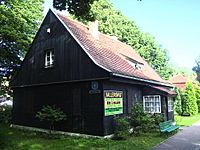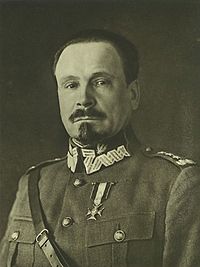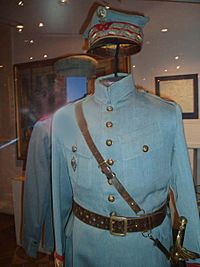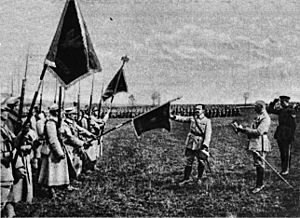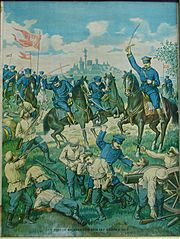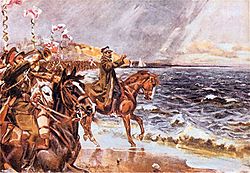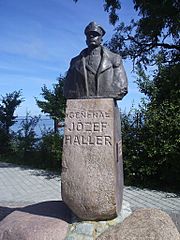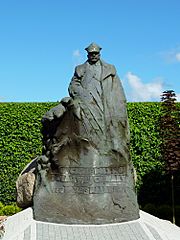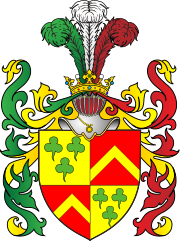Józef Haller facts for kids
Quick facts for kids
Józef Haller von Hallenburg
|
|
|---|---|
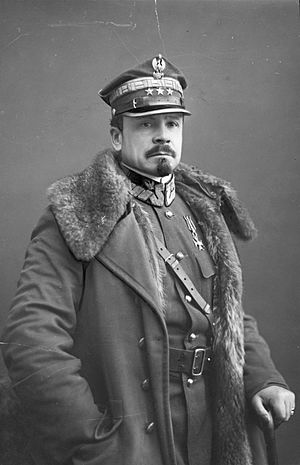
Józef Haller
|
|
| Born | 13 August 1873 Jurczyce, Galicia and Lodomeria, Austria-Hungary |
| Died | 4 June 1960 (aged 86) London, Greater London, England |
| Allegiance | |
| Service/ |
|
| Years of service | 1895–1910 1914–1920 |
| Rank | |
| Battles/wars | First World War Polish–Ukrainian War Polish–Soviet War |
| Awards | |
| Signature | |
Józef Haller von Hallenburg (born August 13, 1873 – died June 4, 1960) was a very important Polish general. He was also a leader in the Scouting movement in Poland and worked to help his country. He played a big part in Poland becoming independent again.
Haller was born in Jurczyce, a small village. He trained as a soldier in Austria. Later, he joined groups that wanted Poland to be free. During World War I, he led Polish soldiers fighting on the Eastern Front.
In 1918, Haller led his troops to break through enemy lines. He didn't agree with a peace treaty that hurt Poland's chances for freedom. He continued to fight against the Russians. After a tough battle with German forces, his army was captured. But Haller managed to escape to Moscow.
Later, he traveled to France. There, he helped create the "Blue Army" (named for their French uniforms). This army fought alongside the Allies against Germany. In 1919, Haller brought the Blue Army to Poland. He helped take back Pomerania and Gdańsk for Poland. During the Polish–Soviet War in 1920, he led an army of volunteers.
After the war, Haller was a member of the Polish parliament. He retired from the army in 1926. When World War II started in 1939, Haller was living abroad. He served as Minister of Education in the Polish government that was in exile. After 1945, he stayed in London and passed away there in 1960. His ashes were later returned to Poland in 1993.
Contents
Early Life and Family History
Józef Haller was born on August 13, 1873, in a village called Jurczyce, near Kraków. This area was part of the Austro-Hungarian Empire at the time. Józef was the third child of Henryk Haller von Hallenburg and Olga Treter. His family had a long history in Poland.
One of his ancestors, Jan Haller, owned the first printing house in Poland in the 1500s. Józef's father fought in the January Uprising, a rebellion against the countries that had divided Poland. His grandfather was a captain in the Polish Army and received a special award called the Virtuti Militari.
Józef spent his early childhood in the countryside. His family was very patriotic and religious. These values, like love for his country and strong faith, shaped him and influenced his future decisions.
In 1882, Józef's family moved to the city of Lviv. He went to school there and later to military schools in other parts of the empire. He then studied artillery at the Theresian Military Academy in Vienna.
Serving in the Austro-Hungarian Army
After graduating from the military academy, Józef Haller became a Second Lieutenant. He then served in the Austro-Hungarian Army for 15 years. From 1895 to 1910, he was with the 11th Artillery Regiment in Lviv. In 1903, Józef married Aleksandra Sala, and their son Eryk was born in 1906.
In 1910, Józef decided to leave the Austro-Hungarian Army. He said he had learned all he could as a captain and wanted to serve his homeland in other ways. He felt that Poland needed him.
Social Work and Scouting
After leaving the army, Haller focused on helping his community. He was very active in a movement that helped farmers work together. In 1912, he became an inspector for a farmers' association. He organized courses on farming, dairy, and agriculture.
He also joined the Scouting Movement and the Polish Gymnastic Society "Falcon". He wanted to make "Falcon" more military-focused and turn the Scouting Movement into "harcerstwo". Harcerstwo is the Polish version of Scouting, which also strongly teaches about Polish independence.
From mid-1912, Haller trained young Poles in military skills. He set up Falcon teams and organized secret courses for soldiers and officers. In 1913, he helped create the badges and terms used in "harcerstwo," many of which are still used today. He also helped design the Scouts Cross, combining parts of the Maltese Cross and the Polish Virtuti Militari award.
World War I Efforts
The Eastern Legion
When World War I began, Polish patriotic groups got ready to fight. On August 27, 1914, Józef Piłsudski ordered the creation of the Polish Legions. Haller helped form the Eastern Legion in Lviv. This group was made up of different Polish brigades.
However, the Austrian army faced problems in Galicia, and the Russian army took over Lviv. The Legion had to retreat. The unit was fully formed but didn't fight. Because soldiers lost morale and didn't want to swear loyalty to the Austrian emperor, the legion was disbanded.
Polish Legions
Soldiers who still wanted to fight against the Russian Empire joined Józef Haller. He became the commander of the 3rd Legions’ Infantry Regiment. On September 30, 1914, Haller and his unit left Kraków for the front lines in the Eastern Carpathians. Despite difficult weather and terrain, his brigade helped defend the Carpathians and stopped the Russians from reaching Hungary.
In October 1914, Haller's brigade reached the Hungarian side of the Carpathians. On October 12, his troops crossed into Galicia near the village of Rafajlowa. They attacked Ivano-Frankivsk and defeated Nadvirna. After a battle at Molotkow, Haller's soldiers had to return to Rafajlowa. In November, the brigade split into two units. Haller's group stayed in Rafajlowa.
On January 24, 1915, Russians attacked the 3rd Legions’ Infantry Regiment by surprise. But Haller's quick actions helped his soldiers defeat the enemy and capture many prisoners. The constant fighting caused about 50% of his soldiers to be lost. After this successful defense, Haller passed command of the regiment to Major Henryk Minkiewicz. On March 14, 1915, Haller was promoted to colonel.
In May 1915, Haller was injured in a car accident and spent 10 months recovering. In 1916, he joined the Colonels’ Council, a group of Legion leaders who opposed Austrian policies. In July 1918, Haller was given command of the 2nd Legions’ Infantry Brigade.
Polish Rifle Division
On February 15, 1918, Haller disagreed with the Treaty of Brest-Litovsk. This treaty reduced Poland's chances of becoming independent. So, Haller and his II Brigade of the Polish Legions broke through the front line near Rarańcza. They joined Polish troops in Russia. Haller was then made commander of the new Polish 5th Siberian Rifle Division.
From March 28, 1918, he took charge of the Polish 2nd Corps in Ukraine. On April 7, 1918, Haller was promoted to General.
Battle of Kaniów
Germany saw the Polish military units in Ukraine as a violation of the Treaty of Brest-Litovsk. On the night of May 10-11, 1918, German troops attacked Polish units near Kaniv without warning. The battle lasted one day. After running out of ammunition, the Polish 2nd Corps surrendered. Many were injured. Haller avoided being captured by pretending to be dead. He used the name "Mazowiecki" and escaped to Moscow. There, he became the head of the Polish Army Commission.
Forming the Blue Army in France
In July 1918, after a long journey through Karelia and Murmansk, General Haller arrived in France. On October 4, 1918, he was put in charge of forming a new Polish Army. This army was made up of volunteers. These included Polish men who had served in the French army, former prisoners of war from Austrian-Hungarian and German armies, and Polish people living in the United States, Canada, and Brazil.
On September 28, 1918, the Blue Army was recognized by the Triple Entente countries as an independent Polish army. In 1918, Polish troops led by Joseph Haller fought German soldiers on the Western Front in France.
The Blue Army's Return to Poland
Even after the war ended, the Polish army in France, known as the Blue Army, continued to grow. It eventually had over 100,000 soldiers. With weapons supplied by France, the Polish Army became a strong military force. Starting in April 1919, soldiers and equipment were sent to Poland. The Blue Army's modern weapons, especially airplanes and Renault FT tanks, greatly helped the new Polish Armed Forces.
General Haller arrived in Warsaw on April 21, 1919, and was welcomed as a national hero. He was given honorary citizenship of Warsaw.
After World War I
Polish-Ukrainian War
The Blue Army was the only well-armed fighting unit in the newly formed Polish Army. So, it was sent to the Polish-Ukrainian front line. Haller's forces won battles against the Ukrainian army, reaching the Zbruch River. In June, General Haller was sent to the Polish-German border to command the army there.
Taking Back Pomerania
As Venice so symbolized its marriage with the Adriatic so we Poles symbolize our marriage with our dear Baltic Sea.
In October 1919, Haller was given command of the Pomeranian Front. His job was to peacefully take control of the Pomerania region, which was given to Poland by the Treaty of Versailles. The takeover began on January 18, 1920, starting with Toruń. More territories were taken from the retreating German Army until February 11, 1920, when the last German soldiers left Gdańsk.
The takeover of Pomerania went smoothly, despite a few small problems. On February 10, 1920, General Haller and the Minister of Internal Affairs came to Puck. There, Haller performed a special "symbolic wedding ceremony" of Poland and the Baltic Sea. This showed Poland's strong connection to the sea.
Polish-Soviet War
In 1920, Haller was made Inspector General of the Volunteer Army, a group he helped create. During the Battle of Warsaw, he led the forces defending the capital. He was also a member of the Council for Defence of the Nation and later led the North-Eastern Front. He saw the end of the war in this role.
Between the Wars
After the war, Józef Haller held several important positions. He was the Inspector General of Artillery and president of the Supreme Military Evaluation Commission. He was also a member of the War Council. From 1920 to 1923, he was the President of the Polish Scouting and Guiding Association.
From 1922 to 1927, he was a member of the Sejm, which is the Polish parliament.
In 1923 and again in 1933, General Haller traveled to the United States. His mission was to support veterans and disabled members of the Blue Army. In 1923, he visited St. Hyacinth Basilica in Chicago and took part in dedicating a monument to the Blue Army. This monument is still there today.
General Haller did not support Piłsudski's May Coup d'État, which led to his retirement on January 31, 1926. In the 1920s, he settled in Pomerania with his wife Alexandra and son Eryk. From 1936 to 1939, he helped organize and lead Front Morges, a group that opposed the government. On October 10, 1937, he was elected head of the Labor Party's Principal Board.
World War II and Later Life
When World War II began, Haller managed to travel through Romania to France. He offered to serve in General Władysław Sikorski's government, which was being formed. In November 1939, he became a Minister without Portfolio in the government. In late 1939 and early 1940, he traveled to the US again. This time, he encouraged Polish people living abroad to join the Polish Army being formed in France.
After the French government fell, Haller went to Great Britain. From 1940 to 1943, he served as Minister of Education in the Polish Government-in-Exile.
After the war, Józef Haller decided to stay abroad. He settled in London, where he passed away on June 4, 1960, at 86 years old. He was buried in the Gunnersbury cemetery. Thanks to Polish Scouts, his ashes were brought back to Poland on April 23, 1993. They are now kept in a church in Kraków.
Promotions
- Captain of Artillery - 1909
- Captain of Infantry - October 18, 1914
- Major of Infantry - October 25, 1914
- Lieutenant Colonel of Infantry - November 20, 1914
- Colonel of Infantry - March 14, 1915
- Brigadier – April 7, 1918
- Major General – November 29, 1918
- Lieutenant General – June 10, 1920
Honours and Awards
- Knight of the Order of the White Eagle
- Silver Cross of the Order of Virtuti Militari
- Commander's Cross of the Order of Polonia Restituta
- Cross of Valour, four times
- Legion of Honour, Class II (France)
- Croix de guerre (France)
- Scouts Cross
- Order of Malta
- Order of St. Stanislaus
- Imperial Order of Leopold
- Order of Vasa
- Military Merit Medal (Austria-Hungary)
- Grand Officer of the Order of the Crown of Italy
- Freedom Cross Second Class (Estonia)
Legacy
After World War I, a group called the Order of Haller's Swords was formed in Warsaw. It honored people who helped Poland gain independence during the war. This group gave out a special award called Haller's Swords, which had the Polish eagle and crossed swords. Some of the people who received this award were Polish soldiers and several Allies.
See also
 In Spanish: Józef Haller para niños
In Spanish: Józef Haller para niños
- The Blue Army
- Poland's Wedding to the Sea


